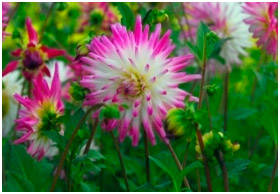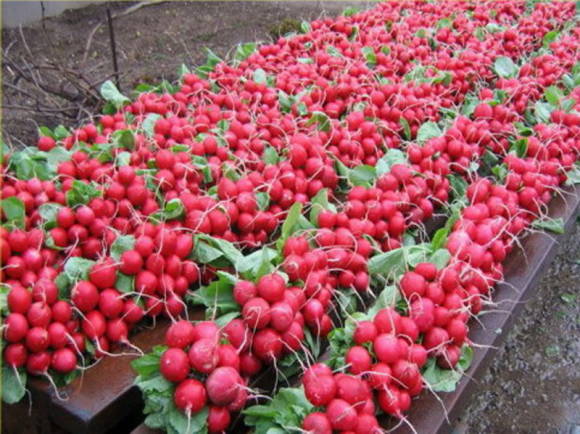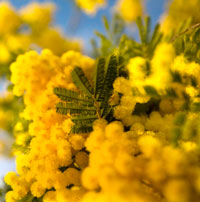As you well know, gardeners grow radishes mainly in the spring, mistakenly believing that in late summer and autumn it will not be able to compete with other vegetables, which are abundant at this time. However, it is this autumn radish that is juicier, tastier, and larger, and, most importantly, the roots of many varieties are stored almost until the middle of winter, when we have long forgotten about the taste of spring radishes.

Summer sowing of radish
Summer crops of radish are somewhat different from early spring crops. High quality root crops can be obtained in the fall by sowing it in early August, when daylight hours begin to decrease sharply.
To do this, you can use the beds that are vacated after growing any crops, except for cabbage. Most often it is sown as a re-crop after harvesting early vegetables (lettuce, watercress, onions on a feather) or a little later used for garden radish after harvesting early potatoes or early tomatoes.
But all these crops had already used a significant part of the nutrients from the soil until August. Therefore, before sowing radish seeds, it is necessary to restore soil fertility by introducing organic and mineral fertilizers into it. At the same time, one should not forget that radish loves fertile soil, but does not tolerate fresh manure.
To do this, immediately after harvesting plant residues from previous crops, they are applied per 1 sq. m beds of 2-3 kg of humus or decomposed compost, 1 tbsp. spoon of superphosphate and potassium sulfate, 1 teaspoon of urea. It will also be very useful to add half a glass of wood ash here. Then the soil is dug up, leveled and grooved on it.
Mid-season and late-season varieties, including the Chinese subspecies, are more suitable for growing in autumn. The growing season for these varieties is 40-60 days; they form large (with a diameter of 6 cm and more) juicy roots of excellent taste, which retain their commercial qualities for a long time.
The crop can be used as food immediately after harvesting or stored.

Radish varieties for autumn and winter consumption
The following varieties are worth noting:
- Dungan 12/8... Root crops are large, weighing up to 80 g. The skin is raspberry-red with white-pink transverse grooves. The pulp is white, juicy, with a slightly spicy taste. The variety is very productive. The growing season from mass shoots to technical ripeness is 45-50 days. Root crops are well stored at a temperature of + 2 ... + 4 ° C.
- Zenith... Root crops of a cylindrical shape with a blunt top, 12-15 cm long, pink-crimson, ripen together, very well stored. The pulp is white, juicy, spicy, of excellent taste. This variety can be grown throughout the summer.
- Cranberries in the Sahara. Radish with thin skin, large, 4-5 cm in diameter, rounded, red, the color really resembles cranberries. The mass of root crops is leveled, up to 40 grams, pulp with a sharp edge, tender. The value is the uniformity of large fruits, a small rosette of leaves. It is characterized by a fast filling of root crops, a small rosette of leaves. Can be sown in spring and autumn. Productivity 3.1-3.5 kg / m2. Re-sowing in mid-July allows you to get an even larger crop in August-September.
- Red Giant... Root crops have a cylindrical shape, up to 15 cm long, pink-red, weighing up to 120 g. They are slightly raised above the ground. The pulp is white, very juicy, with a pleasant sweet-spicy taste. Resistance to moisture deficit and disease is high. The best sowing time is the beginning of August, the collection of root crops is at the end of September. In a greenhouse, the growing period can be significantly extended. The variety does not tolerate thickening of crops, requires light soils with a deep arable layer. Root vegetables can be stored well for up to 4 months without losing their taste.
- Mulatto... Mid-season variety, growing season - 30-40 days. Elliptical root crop, purple. The pulp is white, juicy, tender, slightly sharp. The taste is excellent.Root weight 25-30 g.
- Autumn Giant... A mid-season radish variety with a growing season of 30–35 days. Root crops are white, very large, weighing up to 150 g or more, flat-rounded, 6–8 cm long, 5–6 cm in diameter. The flesh is white, juicy, tender, rather sharp.
- Early Khrustyk. Ultra-early (18 days from germination to technical ripeness), productive variety. The root crop is bright red, round, weighing 20-23 g, yield 1.5-2.8 kg / m2. The pulp is white, juicy, crispy, without bitterness. For a regular harvest, sowing is repeated every 2-3 weeks until almost the end of July.
- Sugar. Early ripening (20-25 days from germination to technical ripeness), fruitful. Root crops are round, bright red, large, weighing 30-40 g, up to 5 cm in diameter, without voids and coarse fibers, with a thin skin. The pulp is white, juicy, very tender, slightly spicy taste, does not flake for a long time. Differs in small foliage and fast filling of root crops. Productivity 3.2-3.4 kg / m2. Re-sowing in mid-July allows you to get an even larger crop in August-September.
- Celeste F1... Mid-season hybrid, growing season 30–40 days. The root vegetable is round, red, weighing 18–23 g. The pulp is white, tender, juicy, slightly sharp, of excellent taste.
- Riesenbutter... Late-ripening variety, growing season 40-50 days. Icicle-shaped root vegetable, pink, weighing 25–30 g. The flesh is white, tender, juicy, slightly sharp, of good taste. Productivity 2.2-2.5 kg / sq. m.

You can take your time with cleaning
Most root vegetables in these varieties have a sweet-pungent taste and do not become flabby. And the shooting and flowering of plants of these varieties occurs only with spring or early summer sowing.
Growing autumn radishes is different than growing radishes in spring. In autumn, the roots of radish, remaining in the beds, retain their commercial qualities for a long time, so their harvesting can be extended until the onset of cold weather.
Radish is a fairly cold-resistant crop, it tolerates frosts well down to -2 ° C, so you don't have to worry about the low night temperatures in September and October.
The late planting of radishes has another advantage - the cruciferous flea, the main enemy of radishes, is not as aggressive in autumn as in spring, so the harvest is almost guaranteed.
Based on materials from the newspaper "Ural gardener", No. 33, 2017







